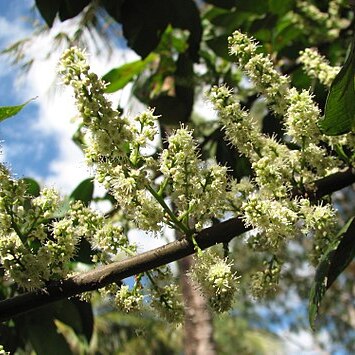(Shrub to) tree, 2.5-25 m high, dbh 10-45 cm, spindly; outer bark nondescript, smooth to with small pustules and furrows, blotched variously grey to plum coloured, inner bark cream to pink to wine-red to light brown, with white fibrous vertical stripes; wood cream to light straw. Branchlets glabrous (to sparsely sericeous when young); flowering twigs 1—5(—15) mm thick. Leaves l-3(-6)-ju-gate; rachis 1-25 cm long, basally terete (to upwards somewhat flattened), glabrous; petiole 0.5-6.6(-8.8) cm long; petiolules up to 0.9 cm long. Leaflets opposite to alternate, (ovate to) elliptic (to slightly falcate), 2.8-23.5 by 1.2-8.7 cm, index 1.8-4.7, usually symmetrical, subcoriaceous (to very coriaceous), usually punctate; base attenuate; margin entire, flat; apex (obtuse to) acute to cuspidate (to caudate), usually mucronulate; upper surface glabrous (except for the sparsely pilose midrib), (thick waxy layer); lower surface glaucous, papillate, glabrous (to very sparsely sericeous especially on the midrib), domatia usually present in some to all leaflets, 1 (or 2) often small sacs on basi-scopic side in axil of second or third nerve (see note 3); venation on upper surface flat except for the basally raised midrib, on lower surface raised; nerves 0.2-3.9 cm apart, marginally looped and joined, (less so in lower part); veins laxly reticulate. Inflorescences axillary (to pseudoterminal), unbranched to branching basally and along the terete, usually sericeous, 0.4-16.8 cm long axis; first order branches up to 6 cm long; cymules cincinnate to dichasial, l-7(-10)-flowered; bracts and bracteoles deltate, outside sericeous, inside glabrous; bracts (0.2-)0.4-1.4 mm long; bracteoles 0.2-0.9 mm long; pedicels 0.5-4 mm long, usually sericeous except for the (sub)glabrous articulate part. Flowers 1.5-2.5 mm in diam., sweet scented. Sepals 5 (or 6), broadly ovate to orbicular, margin pilose, with glands, (outside sericeous), inside glabrous; 2 outer smaller ones 0.5-1.7 by 0.5-1.9 mm; 3 (or 4) inner larger ones 1-2.3 by 0.9-2.3 mm, margin petaloid. Petals 5, (rhombic to) obovate, 0.3-1.8 by 0.2-0.8 mm, white to tinged pinkish; claw 0-0.2(-0.4) mm high; margin pilose, outside and inside glabrous, apex obtuse to somewhat fimbriate; scales 0.1-1 mm long, free, apex not broadened; crest absent (to clavate on slender short stipe, glabrous). Disc uninterrupted. Stamens 8; filaments 0.7-3 mm long, completely pilose, especially basally; anthers 0.2-0.7 mm long, glabrous to papillate, pink. Pistil: ovary 0.2-1.3 mm high, sparsely hirsute; stigma and style 0.1-0.7(-2) mm long. Fruits with 1 or 2 (or 3) well developed lobes, 0.5-1.2 by 0.8-2 cm, smooth to ru-gose-ruminate, glabrous, red when fresh, blackish when dry; stipe 0-3 mm high, broadly obconical to slender; margin blunt; lobes 5.5-12 by 5-8 mm; septa complete. Seeds obovoid, 4-8 by 3-5 mm; hilum 0.7-1.7 mm long.
More
Tree to 20 m high. Branchlets and leaves glabrous. Leaf rachis 2.5–9 cm long; leaflets 4–6, rarely 8, opposite or alternate, narrowly elliptic-oblong or ovate-elliptic, ± falcate, acute or acuminate, entire, 5.5–17.5 cm long, 1.8–6.5 cm wide; lateral veins usually with solitary domatium towards base; petiolules 3–10 mm long; petiole 1.2–3 cm long. Inflorescences raceme-or panicle-like, clustered, ramiflorous or axillary, to 14 cm long; peduncles slender, puberulent; pedicels 2–2.5 mm long. Calyx lobes 1.5–2.5 mm long. Petals minute, half as long as calyx; scales crested or not. Disc complete or incomplete. Capsule 1–1.2 cm long, 1–2.2 cm diam., pale yellow or reddish.


